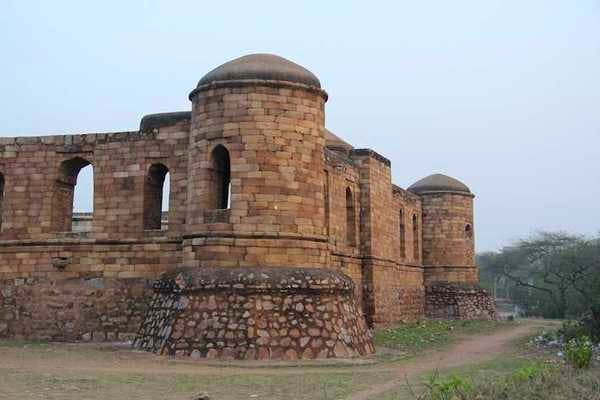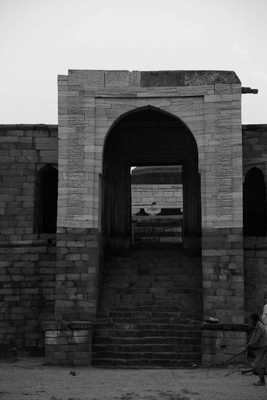By Talha Siddiqui
There was a time when religion was probably more important than it is today; it was an identity, a medium of exchange and at times a reason for exploration. The story of India has seen protagonists from varied religious and cultural backgrounds, and this diversity is responsible for the culturally diverse country we are today. Be it Moguls or the British, all settlers have impacted our religions and cultures, and all these interactions have made our nation religiously diverse. For those of us born post independence, the religious divide has been the subject of many conversations. As Indians, we have always taken pride in the colorful personality of our nation and its inhabitants..
Delhi has a few remarkable examples of “Communal Harmony”- Chandni Chowk, that has major religious places within 500mts of each other - I feel this monument I recently discovered may be louder in its proclamation.
Near Vasant Kunj, tucked into oblivion is Sultan Ghari, the resting place of Nasiru'd-Din Mahmud, Iltumish’s eldest son and brother to a more famous sibling, Razia Sultan. This was first built at the same time as a long list of extraordinary Islamic Mausoleums that dot Delhi today. What it lacks in grandeur, it makes up for in the remarkable spectra of visitors it attracts.

For the most part, little is known about the soul resting in this complex. It is widely accepted that he was a brilliant tactician and an even better negotiator. He was instrumental in increasing the reach of the empire to the Far East. His father gave him the title of ‘Malik-us-Sharq' {King of the East} when he was serving as the governor to Bengal. Riding high on his success in Bengal, Nasir furthered the realms cause by consolidating regions around {present day} Assam and is also believed to have attacked Tibet. Greatness is cut in prime, and Nasiru’d Din was killed within two years of his appointment. Saddened by the untimely death of his son, Iltumish sactioned Sultan Garhi in 1231.
What greets you at this monument is the abject negligence of government institutions entrusted with the duty of taking care of our monuments. One very important distinction between this and other monuments of Delhi is the terrain on one side of the monument. The sharp cut slippery rocks make you forget that you are still in Delhi. While other Delhi monuments, like Purana Qila, Humayun’s Tomb or the Lodi mausoleums have posh and pomp about their surroundings, Sultan Ghari has neither.

From an Architectural point of view, I feel the monument scores low as compared to its neighbors in the city. The tomb lies on a high ground and looks taller than it is {in spite of being a two-layered tomb}, and the actual cenotaphs lie a floor below the main courtyard. The main doorway is quite interesting in its asymmetry. The marble stones in the doorway have been laid only from the plinth {of the courtyard}; the lower part of the arch is in red stone, making it look like an estranged cousin.
The central arch, laid in marble, is engraved with verses from the Quran… if you look closely, you can see “kalash” {lotus} patterns around it, signaling that around 1210- 1220, the influence of Persian designs was minimal, and artisans and craftsmen were most probably Hindus. More interesting is the absence of any stone on the pyramidal roof. Judging from their rather smooth finish, I believe that they just might have fallen off over the years. The central compound has an octagonal structure {which seems to have been planted there in a rather crude fashion}, which forms the roof for the graves below. As a first time visitor, I almost missed the entry to the crypts below. The room below smells of soot, and is stuffy because it is devoid of any ventilation; clear instructions are given by volunteering staff to take off shoes before entering.

From the main courtyard, a staircase leads to a wall overlooking Mahipalpur and IGI airport in the distance. Parrots and horns sporadically interrupt an otherwise eerie silence.
Around the main monuments are ruins of a 17-18th century settlement, a part of which was taken up for restoration in 2005 by the ASI, but now looks unkempt. Wild grass and weeds grow everywhere, making the area uninviting and inaccessible to visitors. The ticket counter to the monument was gutted a few years ago and still needs replacement. The ASI officer in charge is from the neighboring village and seems like a good man who is helpless under the circumstances. He is forced to sit in the open for the most part of the day.
It is not the monument itself, but more what it symbolizes that inspired me to write about it. For the two adjoining villages, the monument is a place where cultures meet - what is basically an Islamic mausoleum has become the epicenter of religious activity for both the communities; it is mandatory for newly weds of both communities to seek the blessings of the saint buried therein. The place is also frequented by people praying for admission, a job, a promotion, or offspring. Every Thursday, there is a religious gathering of as many Hindus as Muslims, belonging to the villages of Mahiplapur and Rangpuri. It is like one of those communal wishing wells we hear about in the legends of Europe.
Around the 17th Dhul’al Qada, {11th month of Hijri in the Islamic calendar}, the gathering at the tomb swells, as devotees from around the nation flock to commemorate the Urs {death anniversary} of the Saint buried therein. Interestingly, out of the three graves, two are unidentified, and if one of these belongs to Nasiru’d Din’s son Nasir ud din Mahmud, the religious activities at the monument would make more sense.

For Nasir Jr. was a devout Muslim, who spent most of his time writing the Quran and selling written copies to cover his personal expenses. He was also a philanthropist who took a keen interest in helping the poor and downtrodden. He also did not believe in luxuries, lived a life of simplicity, is known never to have kept servants, and left the state affairs to trustworthy ministers and noblemen.
The other important significance is that its unimportance in the eyes of the ASI ensures that this monument is cleaner than most others one might visit in Delhi. Moreover, the involvement of communities living around instills faith in the idea {ASI has differed on multiple occasions} that local communities can, with involvement and faith, rebuild and conserve our heritage. While this is true, on the other side we have the residents of Vasant Kunj, who in all probability have not explored the area and remain unaware of the monument.
I know that government institutions can be tricky to work with, but the least that we can do is create awareness about these timeless structures, instill cultural reverence among our children and be proud of our heritage.
There will be many examples of cultural and religious equanimity in our vibrant and vast nation, but Sultan Ghari wins the battle with its obscurity and obliviousness, while still being a part of a throbbing metropolis.
Notes in our Little Black Book |
- Where it is | Oppsite Ryan International School. An adventurous road from Rangapuri village, a dusty road just left off the police post on Mahipalpur Mehrauli road
- Admission Fee | 5 for Indian, I think 150 for foreigners, if you find the ASI person on duty
- Things to carry | Water and snacks on a hot day
- What not to expect | Tourists and paraphernalia associated with monuments.
*
References | Historical accounts sourced from ASI readings, British library readings, Wikipedia.


